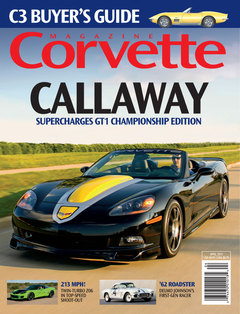With its power brakes and steering, as well as its air-conditioning and electric top, our featured Ontario Orange 1971 convertible is loaded with options. Though such goodies had become the norm on most cars, they were new to the Corvette.
Early Corvettes are best described as Spartan. For the first few years they lacked some of the most basic features, things we take for granted today, such as roll-up windows and outside door handles. A few influential people within Chevrolet, most notably Corvette Chief Engineer Zora Arkus-Duntov, preferred it that way because more content meant more weight, and more weight meant diminished performance. Also, more content would inevitably lead to a higher price tag, something the Corvette’s keepers continuously struggled to avoid.
Against the objections of hardcore performance enthusiasts, the wishes of a growing majority of the buying public won out. Their ever-growing demand for comfort and convenience features could not be stemmed, and it slowly but steadily overcame resistance from Arkus-Duntov and other like-minded GM insiders. Power windows and a power-operated folding top were offered in 1956; power steering and brakes, and air-conditioning appeared on the option sheet beginning in ’63; and a telescopic steering column was added in ’65.

Despite the added weight and complexity of these power assists and other luxury features, the Corvette’s performance capabilities continued to expand right up through the end of the muscle-car era in the early 1970s. It was in this time frame, when fantastic performance lived side-by-side with the most luxurious features the auto industry had to offer, that the Corvette came to epitomize the ultimate grand-touring car.
Joe Shapiro’s option-laden ’71 convertible illustrates the point perfectly. It’s equally at home hitting the Saturday-night drags, taking its owner to Sunday brunch with Alain Ducasse atop the Essex House and then fighting rush-hour traffic on Monday morning.
The heart of this beast is option LS5, a 454-cubic-inch V8 rated at 365 horsepower. Despite a very modest compression ratio of 8.5:1, which enabled it to run on unleaded fuel, the long stroke and sheer displacement of this monstrous big block enabled it to make gobs of stump-pulling torque from idle all the way up to its 5,600-rpm redline. Even with 3.08:1 rear gears, which were standard fare in automatic-transmission cars, and a final drive ratio of 1:1, a well-tuned LS5 Corvette could light up its rear tires for a full city block and momentarily break them loose again at every upshift.

Back in the day, Car and Driver put a new 1971 LS5 automatic Corvette through a full test regimen and came up with the following impressive numbers: zero to 60 mph in 5.7 seconds, the standing quarter-mile in 14.2 seconds at 100 mph and a maximum speed of 141 mph. In the course of their testing, the magazine’s editors reportedly cruised Nevada’s desert highways at 140 mph for some time, with the stereo cranking and the air-conditioning blasting.
Though he hasn’t quite made it to the 140-mph mark, Shapiro knows the elation that big-block power in a well-optioned convertible can bring. He keeps his car well exercised, particularly in the spring and summer when he frequently drives it to shows all around the Northeast.

Shapiro bought the car about five years ago; ironically, he came across it entirely by accident. He went to look at a different car that was for sale and was gravely disappointed when he saw it. The seller mentioned he had another Corvette he was considering selling, and when Shapiro saw this loaded ’71 big-block convertible he knew he had to have it. Though in need of some work, the car had undergone a comprehensive body-off restoration and, perhaps most alluring of all, had virtually perfect paint. That’s no small accomplishment given that Ontario Orange has a fairly high metallic content, and that the Vette is painted in original-style lacquer, not base coat/clear coat.
Shapiro is an old-school hot-rodder with an unrepentant obsession for taking care of even the smallest details. After getting the car home, he identified various incorrect reproduction and later GM parts that were used during the restoration, then methodically tracked down new-old-stock and mint original examples to substitute. The single most difficult-to-find item, he reports, was the proper engine fan, the design of which was unique to cars equipped with both air-conditioning and a big block.
Shapiro also attacked the minutia, things like the original “friction tape” used to bundle wires and vacuum hoses together, correctly configured and dated hoses and clamps, and even correct tire-valve stems and caps.

All of the hard work has paid handsome dividends on the show circuit, where the Corvette consistently wins best-in-class awards and accolades for best engine compartment and best paint. The car has also earned the prestigious Top Flight award from the National Corvette Restorers Society.
Of all the honors earned, however, Shapiro is proudest of the Exhibitor’s Choice Award given to him this past summer at Vettes at the Vanderbilt, a Long Island, New York show. “That meant a lot to me,” he recalls, “because there were a lot of beautiful cars there, and it was nice for my car to be recognized by so many knowledgeable Corvette enthusiasts.”







